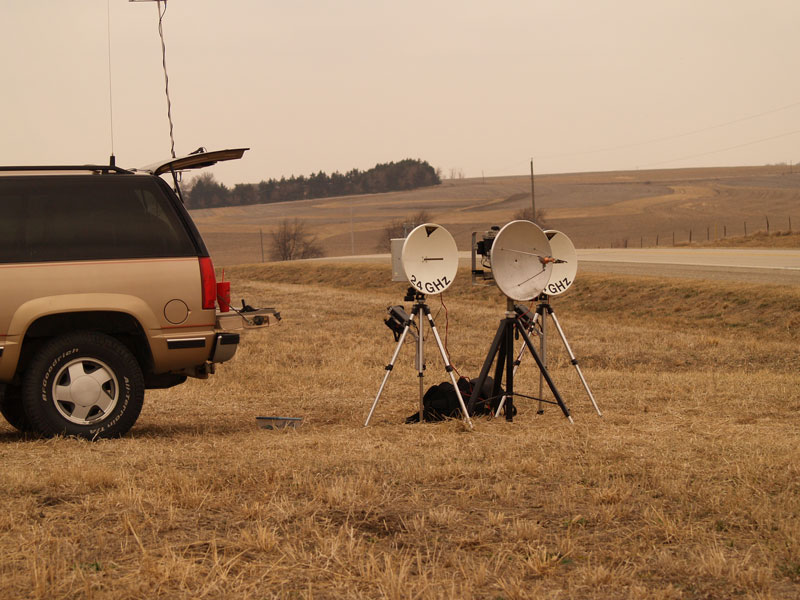
And some good propagation info too!
Introduction:
Over the last few years, I made some pretty neat QSOs on the VHF+ and microwave bands. Here are brief descriptions of some of them along with the related propagation info or specific circumstances. Hopefully, some things may be learned here...however this is probably more for me. As I get older, the tales get bigger and having them put down here will keep me on the straight and narrow :)
73 - Mike - KMØT EN13vc
Close but no Cigar!
Signals Heard both ways for Grid #20 on 24 GHz
On Sunday March 30th, Gene - NØDQS went to EN20px to try and catch some rain. We had been watching the cool rain come through over the past few days, with hopes of a good cell at the midpoint. However, when Gene got to the location, the cell had tracked more north and was very near my QTH. Since he was there, we decided to give it a good try. There were spots closer in distance in EN20, but that would have taken longer to get too. Gene got the frequency reference all set up along with both 24 GHz dish units and the portable 5.7 / 10 GHz dish. A few weeks ago, Gene stopped by the house and picked up the other unit and took them out to test side by side. After some testing, it appeared that they were both working very closely in RX performance, so we were confident with the equipment.

Quite an impressive lineup of firepower....

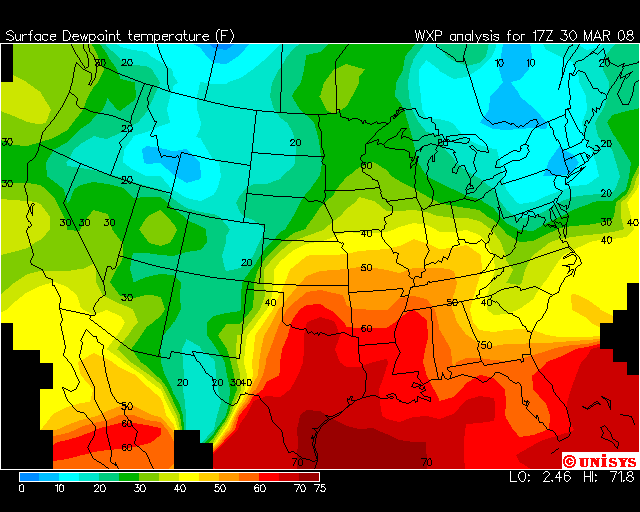
The rain was there, but in the wrong spot...dew points were in the 30s, so that was good.
We went back and forth for about 30 minutes with no luck. Signals on 10 GHz were really pretty good on the direct path, but with some elevation on my end having the rain so close. During that time, we re-peaked a number of times on 10 GHz and noted the rain cell movement, sometimes I would be on direct path, but sometimes it would peak off the side and the elevation would change. Gene was always hearing my 10 GHz on the direct path and with his dish on the horizon.
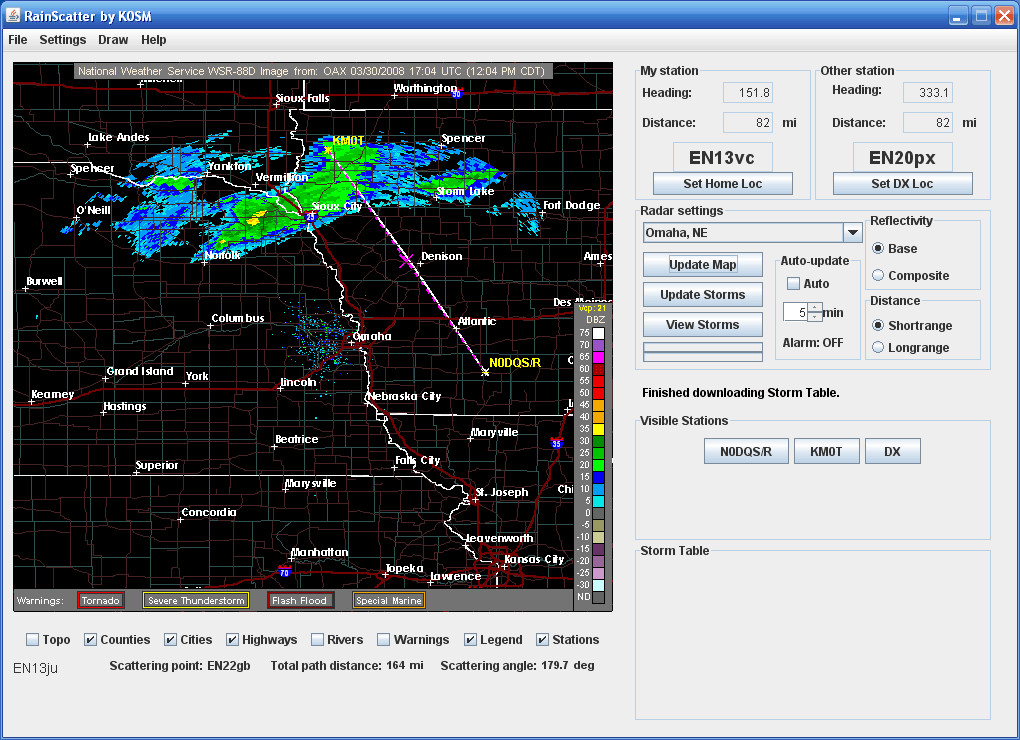
Rainscatter Plot - showed rain right on me but no drops here....
After lots of going back and forth, we decided to get both 24 GHz dishes going on Gene's side with their beacon keyers. A quick re-peak on 10 GHz and I then started moving my system around much more than before in elevation. I also decided to give a try to elevating much higher than the 10 GHz elevation peak. That's when I heard one of Gene's dishes. A quick call to him to say "don't move anything" helped me with some more time to try and get a good signal. When I though I had it peaked, I sent back to him and he indicated he was also hearing me! However when we tried to send calls and QSO data, the signals were gone. We re-peaked again on 10 GHz to find that the path and peak had again changed. Back to 24 GHz and I heard him briefly again, but at a different elevation. This went on for about 15 minutes and we were not able to get a good enough signal to make an exchange due to the moving reflection point. Then the storm was pretty much east of me and 10 GHz was way down. Signals were marginal at best with very brief points where signals were good enough to copy. I managed to do an on the fly screen capture of the SDR-1000 window. I was using the PowerSDR "Peak" function button to see if something popped up above the bandscope base level, that's how I first found Gene.
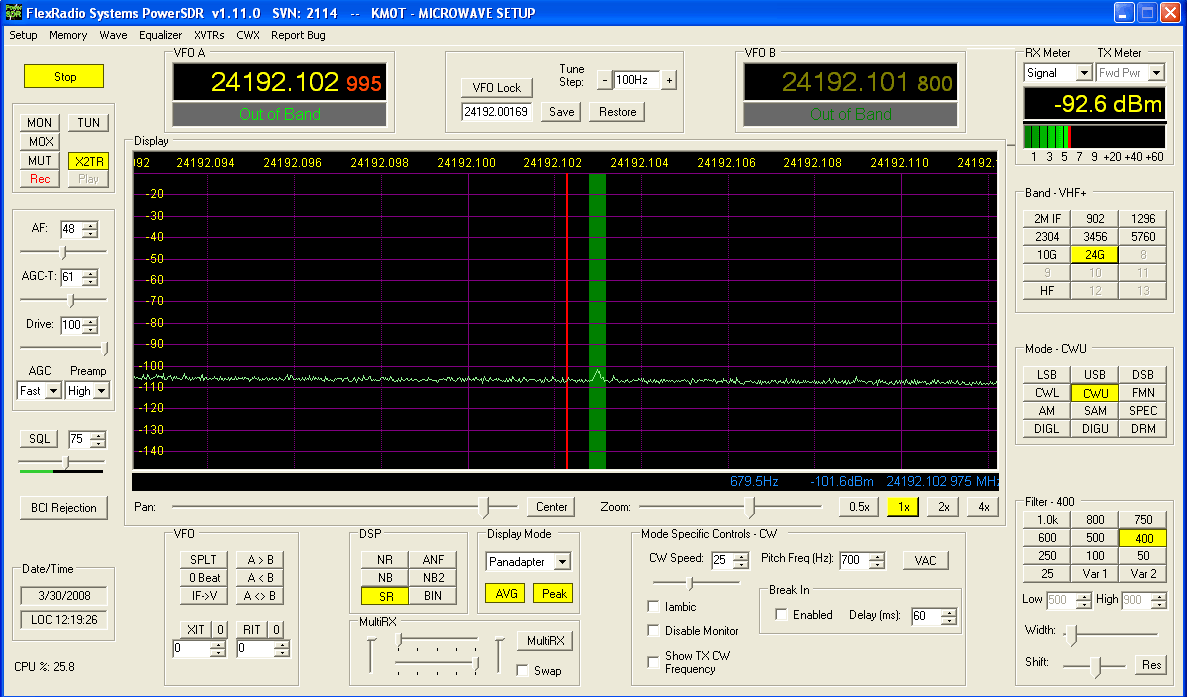
Peak function sure helped...I think that the spike to the right of the one in the filter was the other 24 GHz dish on a slightly different heading.
When we gave up, I put the dish back to the elevation on where I heard Gene the loudest. I went outside to see how much it was elevated, and boy was I surprised! To think I could be elevated at 25 to 30 degrees, and Gene being on the horizon at 165 miles, goes to show you the fact that we even heard each other was quite amazing. We are now confident that when the rain with cool dew points is near the midpoint, we will make grid #20.
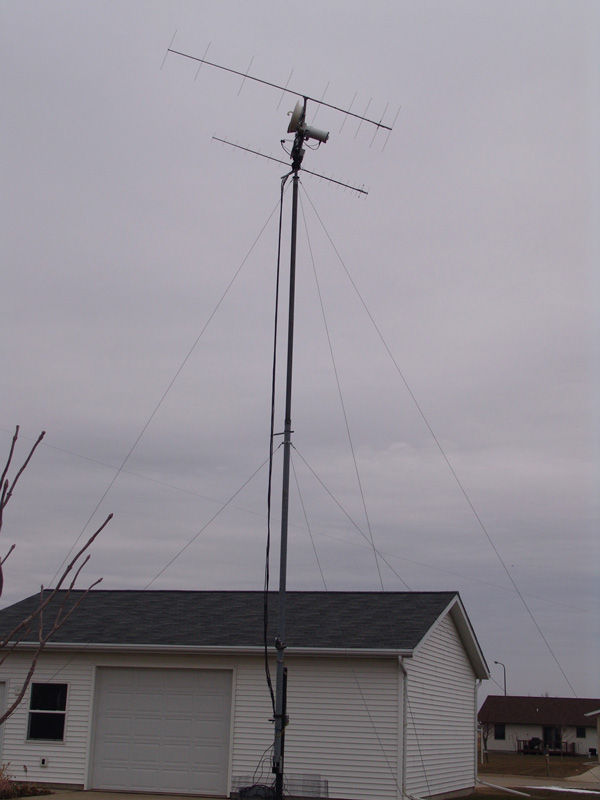
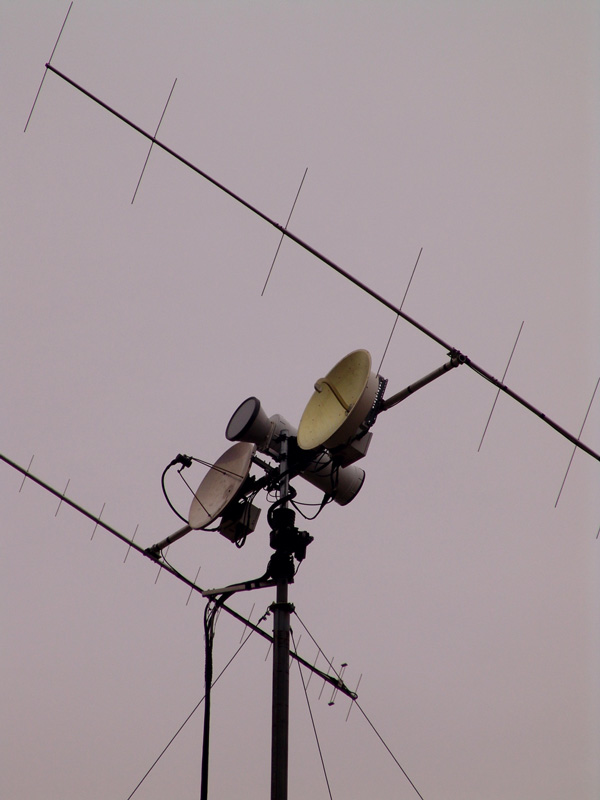
With the peak function off, and just looking at the average band scope level, it was easy to miss the signals since they were very variable and weak. After it was all over, I went back and replayed a number of wave files through the SDR-1000 to see what I might have missed. I also decided to check out the use of the SDR-1000's waterfall function. It was neat to go back as I was able to tune it in, I clearly heard CQ CQ CQ NØDQS/B from the beacon keyer setup...pretty cool. Better luck next time!
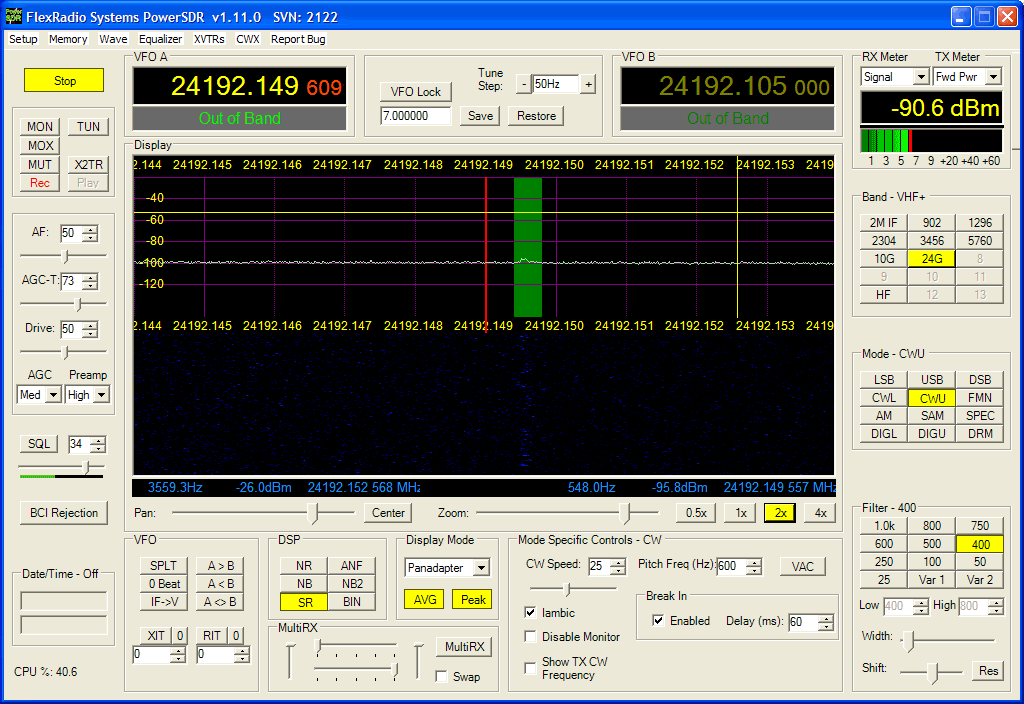
PowerSDR with the Waterfall and "Peak" function on....nice tools for weak signal DXing!
GRID #19 on 24 GHz - EN13VC to EN31AX
SNOW / RAINSCATTER
On Saturday, December 8th, Gene - NØDQS went out to do some 24 GHz portable work. One of the grids we needed was EN31 near Des Monies. We had tried there a few times over the years, but those trials were always in the Summer, so the path loss seemed to be getting in our way. The distance was just a bit longer than what we had been able to work before during the humid months.

Radar Plot from RainScatter for the new grid. Precip shown in the midpoint is about only10 DBZ. Pretty low level stuff!
Gene and I had been very busy the last year, so getting together to give some more tries on 24 GHz had been real tough. However, this particular weekend looked good and we had lots of possibility of snow and sleet in the area. Gene took off in the morning and made it there around 11:30AM local. The snow was not in my area yet and we had some stuff rolling in from the west. It looked like a good setup. Temps were pretty cold so the dew points were way down, even with 90% plus humidity on both sides.
We had always struggled too with the obvious issues of pointing, and then of course frequency calibration. So I had spent some time in the last year gathering and building equipment for "portable" frequency markers. The setup did not turn out to be too portable, but it worked!
The system essentially consisted of a Pyrojoe modified 12 GHz Macom PLO fed at 108 MHz. The PLO output was fed into an Edgartech 12 GHz doubler and gave a nice signal at 24192.000 MHz. A nice bonus was that there was a harmonic out of the PLO that gave a marker also on 10368.000 MHz!
Now, to get the PLO on the money, it needed an accurate 108 MHz source. So I took a PTS-160 frequency synthesizer that had a 10 MHz input to give it the standard reference. From there, I built one of those Jupiter GPS 10 MHz PLL lock circuits from Pyrojoe on eBay where it utilized a 10 MHz Isotemp OCXO. Information on the web from Mike - N1JEZ and James - G3RUH on the disciplined 10 MHz GPS source was very helpful in putting that all together. Thanks guys!
So, when it was all done, the 10 MHz GPS locked OCXO drove the PTS-160, which was set to 108.000 MHz, which in turn drove the 12 GHz PLO. All that stuff got loaded up with Gene and off he went with the portable dishes for 10 GHz and 24 GHz.

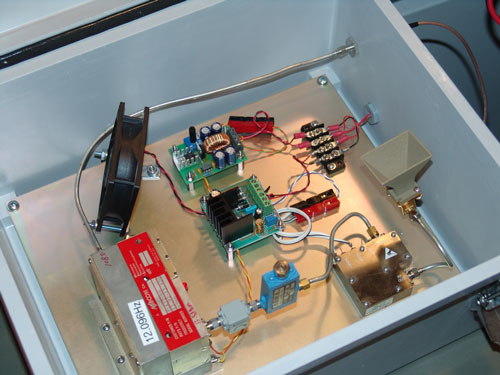
Here is Jenna with the PTS-160 and the 24 GHz freq source.
The 12V to 120V inverter is for powering the PTS-160 from the car battery.
Note the messy work bench, lots going on!
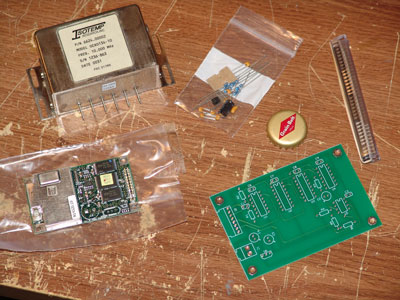
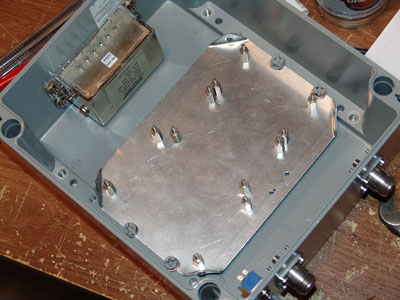
Here are the basic parts for the "Jupiter" GPS Locked 10 MHz OCXO source - and initial box hardware setup.
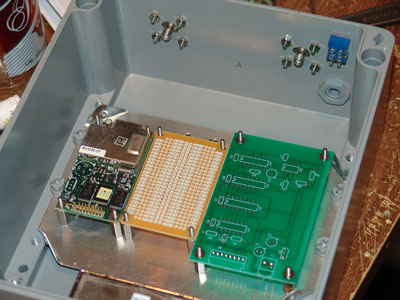
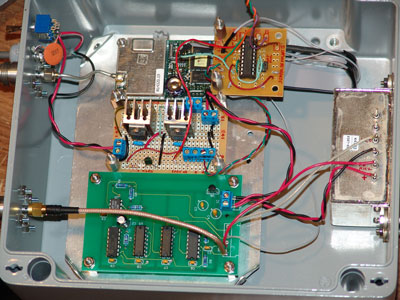
Inside view with boards and the completed unit. Note the GPS "3DFix LED" PIC IC at the upper right courtesy of W1AUV.
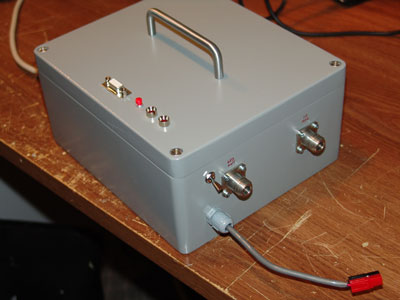
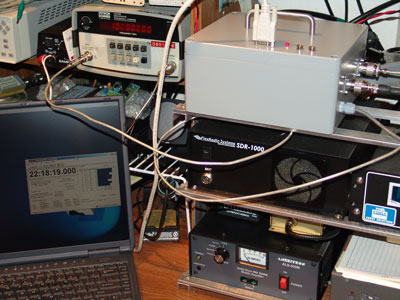
The box with the top indicator lights - 1 sec tic and GPS Lock LEDs...also a testing view - 10 MHz is right on!
Gene got into position and setup both the 10 GHz and 24 GHz dishes. We had found in the past that having the 10 GHz dish along was always helpful in peaking my 24 GHz system since I had both bands mounted on the same boom of the tower. Then Gene could also tell within a few degrees that his 24 GHz was peaked as well.

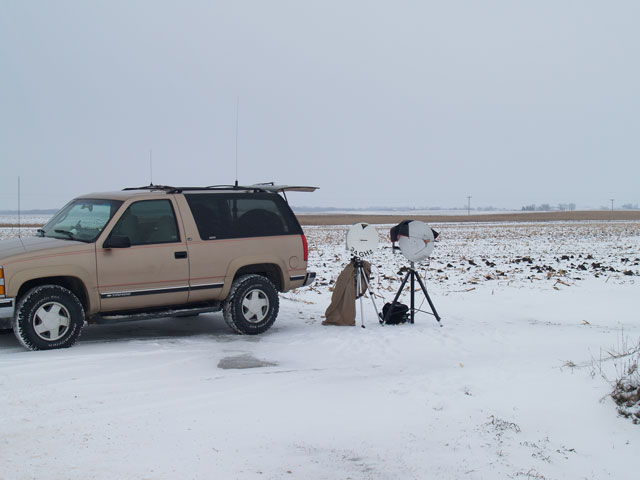
Gene - NØDQS / Portable in EN31ax - 12 Degrees F Brrrr! Nice flat path towards EN13vc.
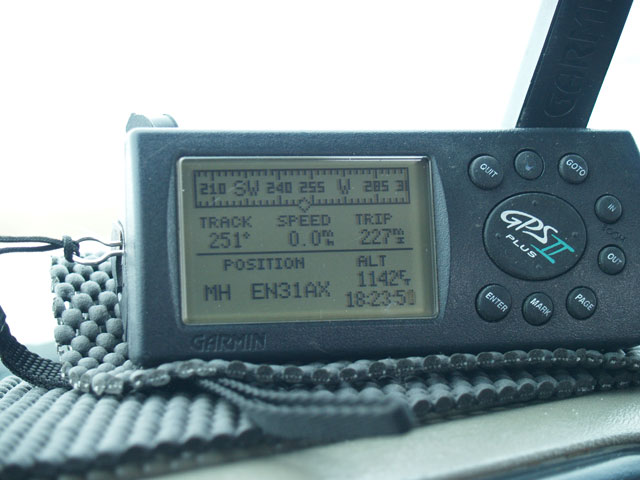
Gene then listened for the 10 GHz birdie freq marker and calibrated the real "100". I had a GPS locked freq source here in the shack so when we hooked up on 10 GHz for peaking, we also knew that the frequency reference he had out in the field was working, as his 10 GHz signal was right where it was supposed to be.
We noted that the 10 GHz signals were fairly strong, but wide, a typical rainscatter signal. The beamwidth was pretty wide too, which we expected due to the scattering, but swinging back and forth got the dish pretty well centered. Also, there was no elevation peak on either side, as expected due to the low altitude of the precip per the DBZ shown on the radar.
Gene then went to 24 GHz and found the locked frequency reference and dialed up to the "100" mark on the FT-817 IF radio. When he was all ready he began to send a beacon. We were on the cell phone at the time and I said, "Hey we have a problem, your 300 Hz off!" Signals were 10 to 15 db above the noise on my end, perfect CW copy. We tried repeaking now that we had each other, but we were right on the money.
The wide signature to the CW signal indicated a scatter type of signal, but it was totally on the direct path and no elevation. We tried on SSB and heard each other 4x1 to 5x1 copy. FM was marginal at best, it just wasn't there as I could only pull out a few words here and there on that mode.
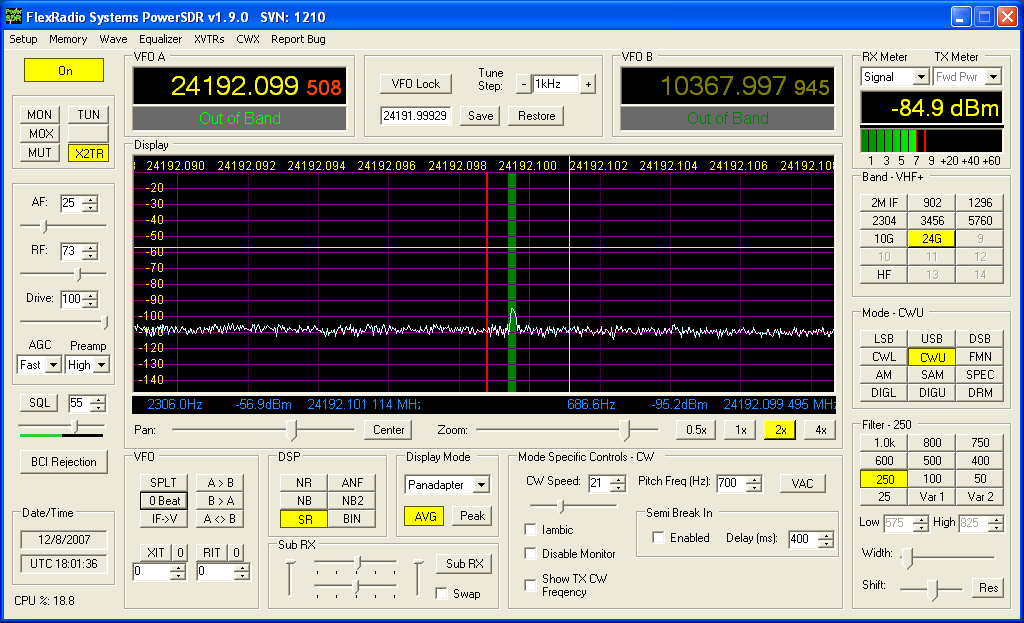
Screen Shot from PowerSDR - nice to see a strong 24 GHz signal at that distance!
We then re-pointed towards a bit of rain / sleet to the west to do a very skewed path. (Shown in green on the RainScatter radar clip) Signals were there again, but not as good and only CW was possible. The signals moved around then due to the doppler caused by the moving snow / sleet.
QSO Data was EN13VC to EN31AX: 138.6 Miles - 223.1 km. (WinGrid Distances) Not a record, but a good distance and a new grid! Temp was 7 degrees on my end and 12 degrees on Gene's. Humidity was 90% but the Dew Point was around 7 on my end, similar on Gene's side.
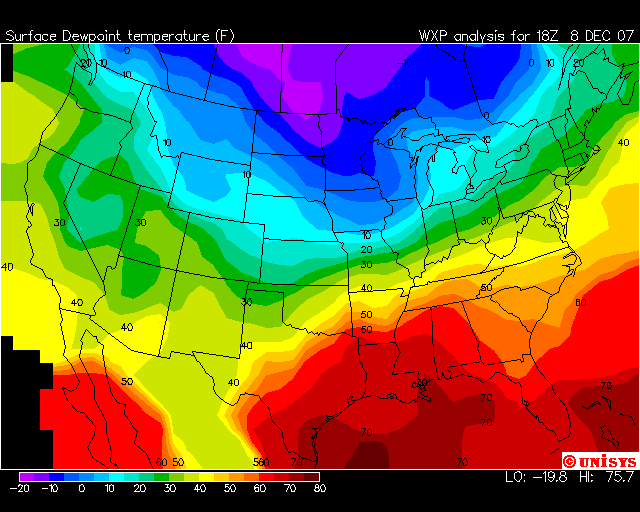
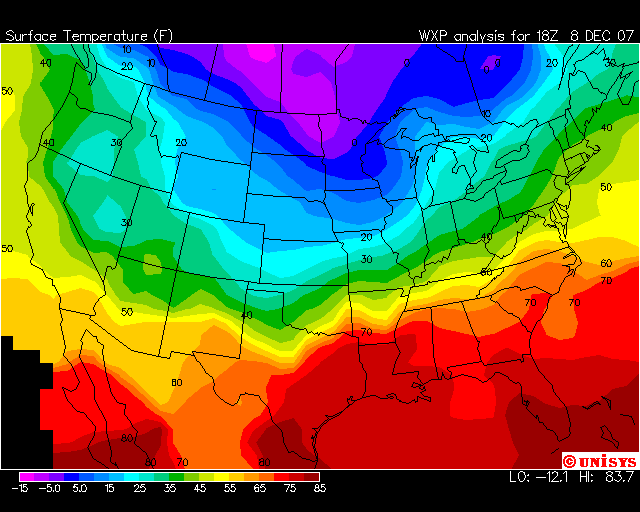
Surface Data - Dew Point and Temp
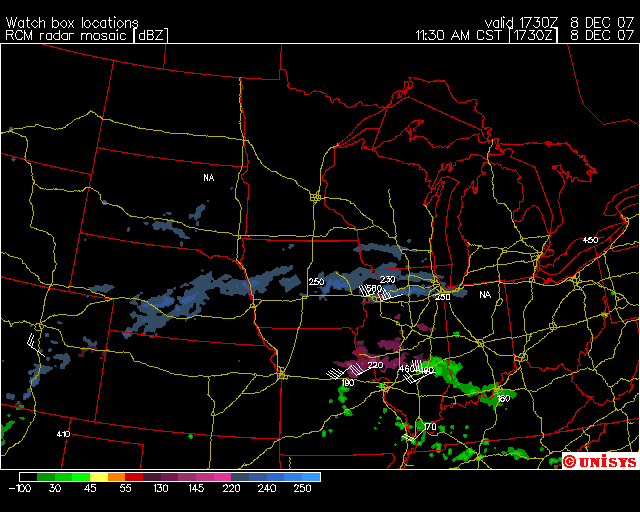
Unisys Radar Plot
Gene packed things up to head to EN20, but got delayed in Des Monies as he had to make a stop there. He got to the site at EN20 right at dusk. The snow / sleet had moved out by then at the midpoint and was right on top of me, so we were not able to make a QSO. 10 GHz signals were barely there as well. Gene got into alot of ice and had a really crappy drive home, sorry about that Gene! Thanks for getting out there! 73 de KMØT.
RAINSCATTER - EN13VC to EN58GK
On 8-14-07, I was sitting around wondering what to do when I got an email from Fast Eddie, VE3KRP via the local 10 GHz reflector asking if I was around. I took a quick look at the radar and saw a large line of storms lining up for a great chance between us. I let Eddie know I was QRV and he indicated it would take about 30 minutes to get to the spot where he operates.
In the mean time, I saw a bunch of signals on the 10 GHz band via the SDR-1000 bandscope. Bill, K0AWU from EN37 was booming in and that helped get me on the hot spot for the scatter point. We worked on FM just like next door and chatted about the recent UHF contest, rag chews via rainscatter FM on 10 GHz, gotta love it! Then Jim - K0KFC popped in there for a quick contact.
The storm was slowing moving to the east as I got hold of Eddie at his position. He said he was hearing me no problem and I believe I saw him briefly at that time. However, it was very weak. With the spotty cell phone service he had, we had to make many calls to just get a few words in, so I just started beaconing up that way for a few minutes at a time. We finally made contact around 0114 UTC, but it was really a tough one on this end. I then worked Barry - VE4MA random in EN19 side scatter of the cells and we tried to get a good peak for 5.7 GHz, but no go there. I chatted with Bill - K0AWU one more time and then saw VE3KRP calling again, he was much stronger as the cells moved a bit east. We made another contact at 0124 UTC. He was 52R on CW, pretty wide for sure and some QSB was in there. I received a 56R report from him. He was having no problem copying me with my power level, he runs about 2 watts on his portable setup. The next hour plus I was reading Bill - K0AWU on and off and also then worked Gary - W0GHZ via random.
Here is the screen shot from Rainscatter....thanks again to Andy - K0SM for his fine software program!
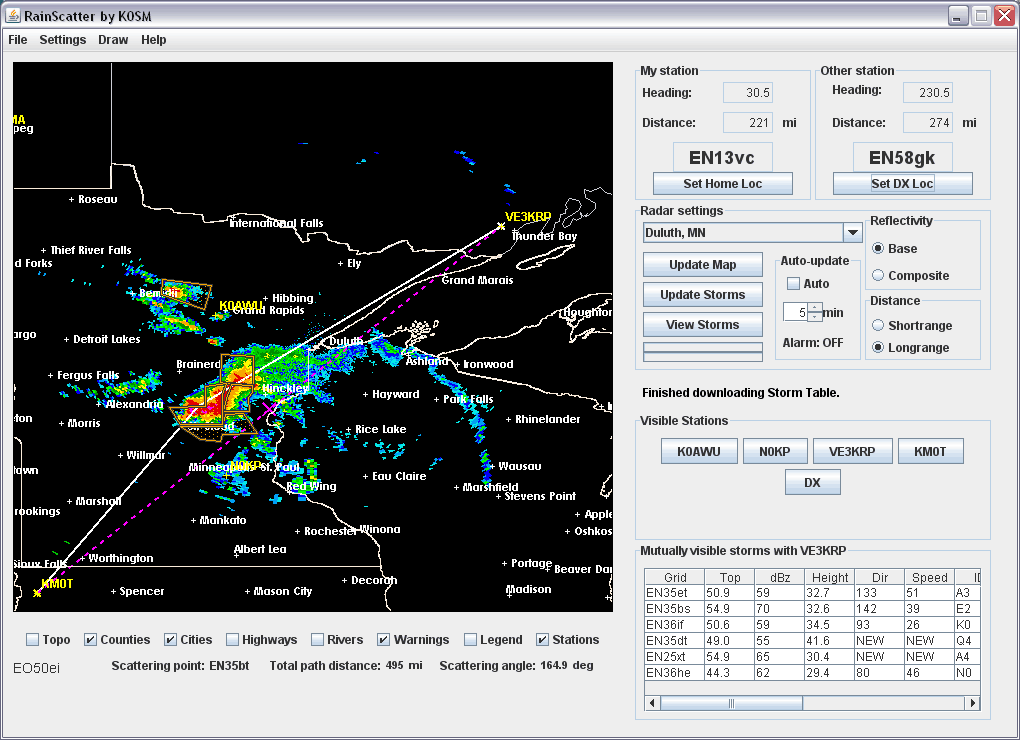
Rainscatter Screen Shot.....you can just see VE4MA's QTH on the upper left.....that contact was nearly a 90 degree path! K0AWU's QTH off of this cell is a chip shot, easy pickings. Jim - K0KFC in EN35 and Gary - W0GHZ in EN34 were pretty much a backscatter path. The path to Eddie was nearly direct. Good thing we worked when we did, because as the storms moved east, they broke up when they hit the direct path line.
It's another new grid for me on 10 GHz and I'm told it may be a new USA/VE 10 GHz record. EN13VC to EN58GK - 492 miles - 791 km! This was Eddie's best DX to date! We had tried a few times over the last year or so with no luck, glad we could make the trip!
The rainscatter season is ramping down here this time of year now, hopefully I will have some 24 GHz contacts to share here in the near future. Things are cooling off and the dew points will be dropping. Looking for "cool" rain to do some DX on 24 GHz!
RAINSCATTER - EN13VC to EN73CB
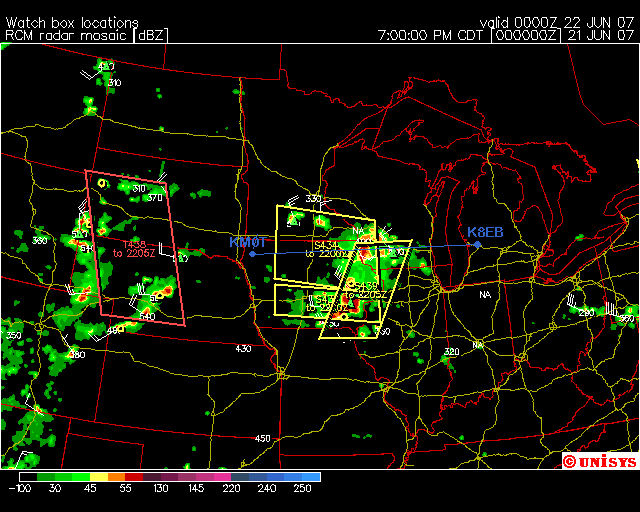
These first few days of the summer of 2007 have proved be fruitful in terms of VHF+ operating. We got some Es on 6M on June 20 and I managed to work a new country on 6 Meters. It was V26HS and #72. Its been over a year since I picked up a new one.
However, we started to get some serious large thunderstorm cells running though the region. These were not typical lines of storms, but ones that just seemed to pop up out of nowhere. The first night I had a chance to mess around, Steve N4PZ in EN52 was beaconing off of a pretty small by violent cell just outside of the twin cities. I also heard that Jon, W0ZQ was out and about and he was reporting a large hail event. I swung the dishes around and there Steve popped out on the SDR-1000 bandscope…we worked quickly and from what I recall it was the largest skew path we had worked, nearly 90 degrees between us.
Shortly after that, Jon – W0ZQ got home and we tried on the lower microwave bands. We worked with no problems on 902 thru 3456 MHz. We worked on FM on 1296 and 2304 as well with very good signals. I heard Jon without any problem on 3456 FM, but he was not quite getting me good enough there. The interesting thing about these contacts is that Jon’s path was about 5 miles to the cell, basically pointed SE. While I was pointed NW at the cell about 170 miles away. It too was basically a 90 degree skew path with me making up the majority of the distance. Signals on 2304 and 3456 CW and SSB were S9. There was only a small amount of Doppler as I was able to copy Jon on SSB pretty well. CW was wide, about a 800 Hz hump. So, for those summer contests were you cant seem to find any tropo , look for thunder heads and use K0SM’s program “Rainscatter!” to get lined up!
The next day, June 22, folks were reporting a cell up by SE Minnesota. Not really knowing where it was yet, I just swung the dishes up there and saw a big hump pop out on the SDR-1000 bandscope. It was Steve, N4PZ again beaconing from EN52. I got peaked up on the hot spot and then saw another weaker hump. It was K3SIW – Garry CQing from the same area. I called him but did not hear a response. I then looked up at the screen and saw that he was Doppler shifted down over 2 KHz, so I only heard the last few letters of his call. I called back again and saw a response, but he had dropped out by then.
I then saw a real weak hump up about 3 KHz from N4PZ’s beaconing signal. I tuned in there and swear I heard K2YAZ in EN74. Bob and I had been trying to work for some time off of rainscatter. I quickly jumped on the 10 GHz reflector and saw that Bob was beaconing there on 10,368.103. I was not hearing things. I threw my beacon on and posted that I was calling Bob and that everyone else please standby so I would not get QRMed. Bob posted back that he was hearing me weakly. Then right there another posting came up and it said that Erv – K8EB was hearing me in EN73! What the heck was going on, It never dawned on me until I looked at the radar that we had a perfect path.
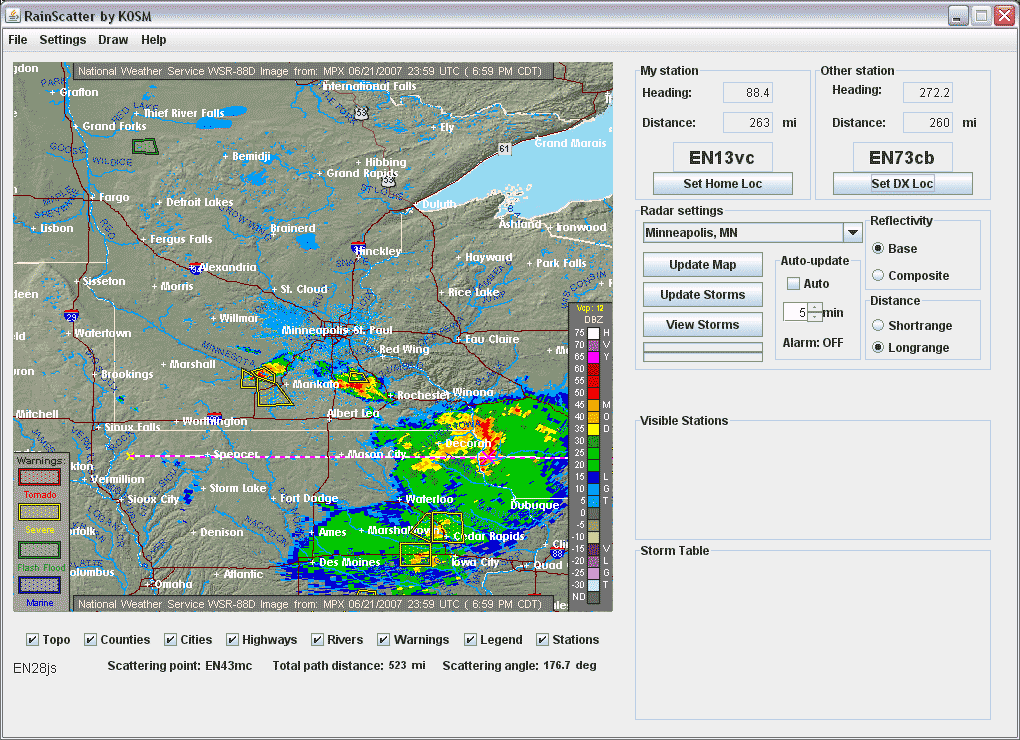
The path was pretty long - so we need two rainscatter screens to really show it! Andy, we need "Rainscatter" Wide Mode! Note that the midpoint is by the cell at Decorah Iowa. It doesn't line up much better than that!
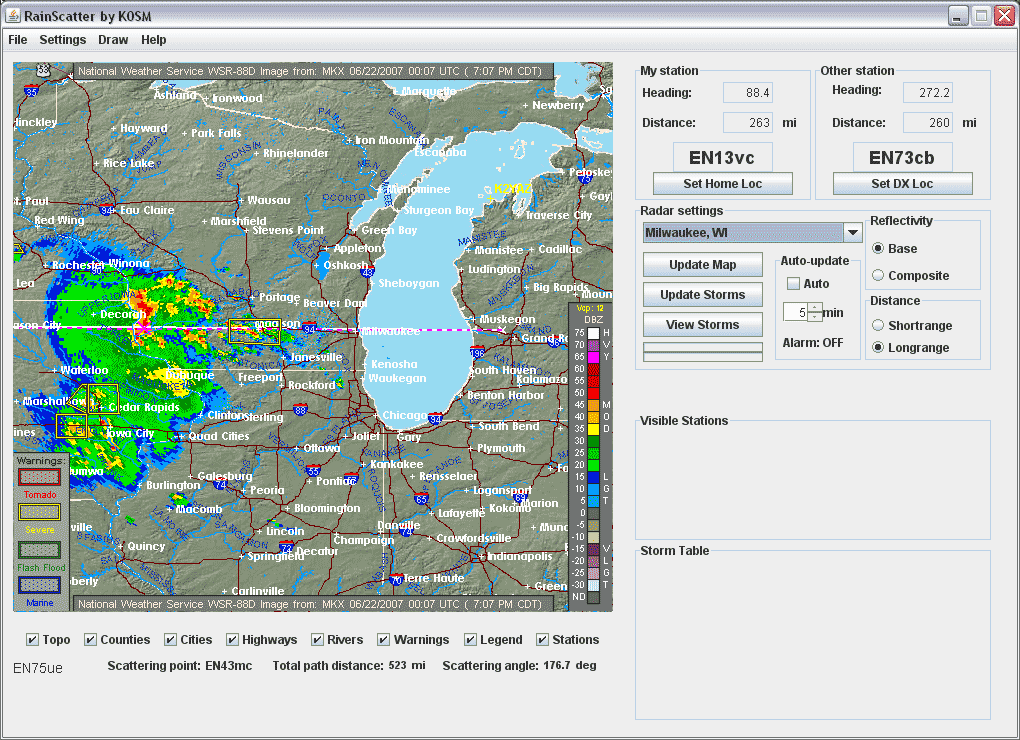
I let up on the beacon and there Erv popped out with Q5 CW about 53R to 55R. We quickly worked with little effort. I then decided to check the distance and boy was I surprised! EN13vc to EN73cb was 526 miles – 847 km, good enough for a 2nd place on the US 10 GHz rainscatter distance! (These are “Wingrid” distances)
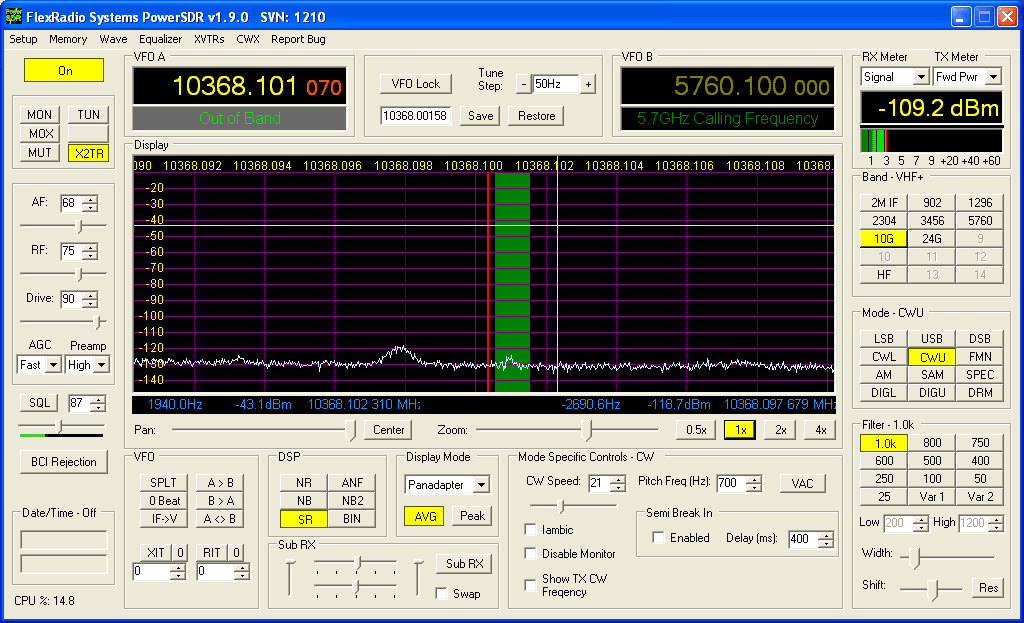
The above screen shot from PowerSDR and the SDR-1000 is the signal from Erv -K8EB in EN73cb on 10 GHz. Note the wide spread on his signal. Below him is the wide hump of N4PZ from EN52. If you look close you can see another wide signal towards the high end of the bandscope, probably K3SIW in EN52. Kind of neat to see multiple 10 GHz stations at the same time!
During this time jockeying around the dishes to get on the hot spot, my Alpha Spid rotor box gave out. I had been having some issues with an intermittent failure in the relay that made the rotor turn counter clockwise. I knew what the problem was, I just never got around to fixing it. So as one of Murphy’s Laws, it failed at the most problematic moment. I could not get the rotor to come back to the cell!
I called Erv on the phone to talk about the contact and he mentioned, “Boy, we should have tried 5.7 GHz!” Man, being so wrapped up with the 10 GHz contact, I never thought about it at the time either! I told him that my rotor was not working, but I would quick take the control box apart to see if there was anything I could do. I told him I would quick call him back.
I got the cover off and messed around a bit. There are two relays that control the voltage up to the rotor, one of the relays would not respond. After tapping on them, checking for bad soldering, etc. I still could not get it to go. Then I thought, hey if one relay is working, why not swap the wires to see if it will go back the other way. Sure enough it did, albeit the heading on the box was all messed up.
I have a camera on the tower, so I knew from that where I should be pointed and got the dish back on pretty much on heading. I got Erv on the phone and he said he would beacon for 5 minutes on 5.7 GHz and then if nothing heard, I would beacon back for 5. With him going first, it would give me some time to figure out how to get on heading.
When Erv's time came up to start beaconing, I saw him right away on the bandscope. It took me about 3 minutes of peaking him up by swapping the wires back and forth to see if I could get a better signal. I also messed with the elevation control. I had to sit there for about 2 minutes watching his signal before his time was up. This is the most agonizing thing you can do to a microwaver, as one knows that the thing that’s making this all possible could change in an instant! However, luck would be such that when his time was up, I was still copying him pretty well. Mostly Q5 and 51R CW signals! There was a bit of QSB where he got covered up for a few moments in the noise.

The above screen shot from PowerSDR and the SDR-1000 is the signal from Erv -K8EB in EN73cb on 5.7 GHz.
Since this was almost an exact direct path heading, no Doppler to speak of was experienced on both 5.7 GHz and 10 GHz. There was however the typical spreading of the signals due to rainscatter. The timing on this having the storm’s hot spot pretty much at the midpoint between us was a very fortunate thing. As it turned out, the 5.7 GHz contact for distance is the longest one made in the US on rainscatter! Thanks for being there Erv!
Turns out this is grid #46 on 10 GHz and grid #40 on 5.7 GHz. All these grids are terrestrial contacts, no EME here on the microwaves. Its been quite some time since I got a new grid on those bands! Oh, a few days later I worked HH4/W3CMP on 6M for #73! What a week in radio!
K8EB's station consists of a 3' dual band LUA feed 5.7 and 10 GHz dish, running DEMI transverters and 10 Watts on 5.7, 8 Watts on 10 GHz. He is running preamps as well. The dishes are at 70 feet.
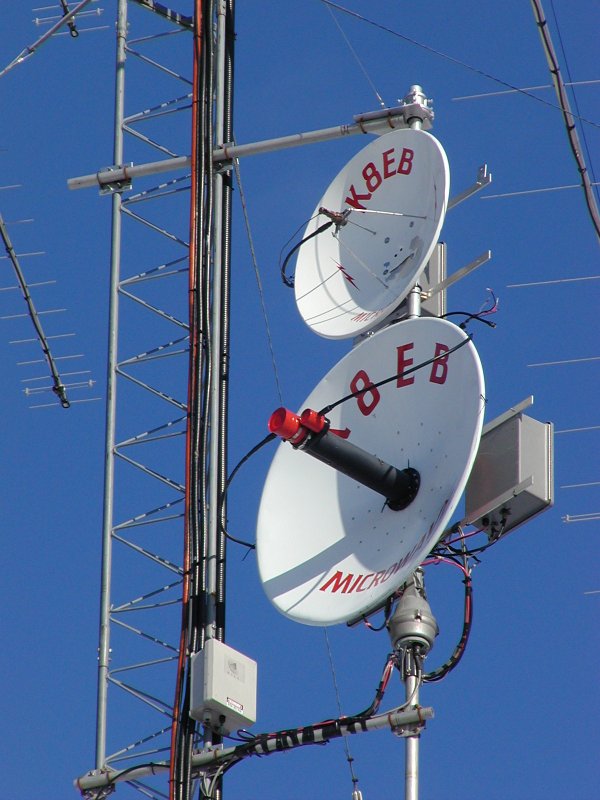
K8EB Dishes - 5.7 and 10 GHz on top - 2.3 and 3.4 GHz on the 4' dish.
This is NOT April Fools!
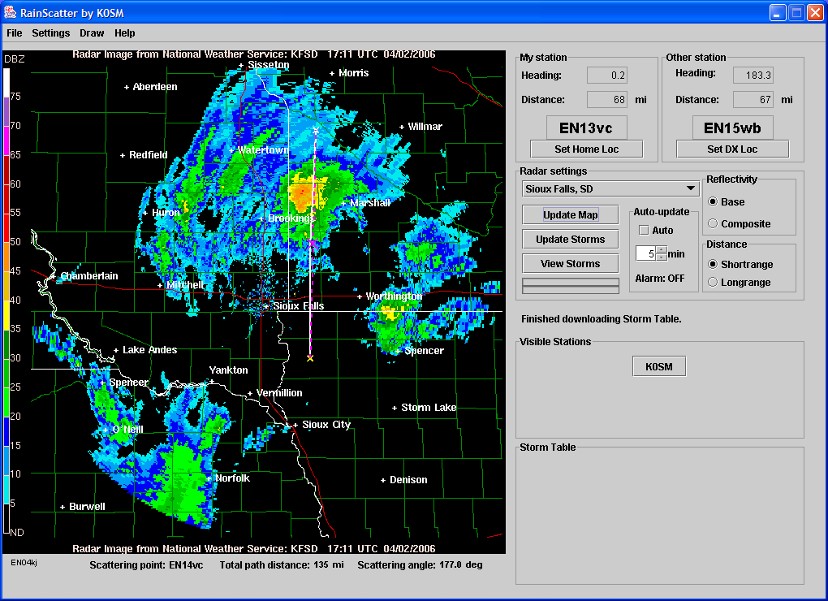
KØSM's Program Rocks Again!
The "Gridinator" claims its 18th Grid! Via 'good old rainscatter' on 4-2-06 at 1717 UTC
The contact was made with Jon - WØZQ - who was using one of the KMØT portable 24 GHz units.
EN13vc to EN15wb - 135.3 miles - 217.7 km - 519 to 539 fairly solid cw signals. There was just a hint of hash on the signal.
The path was direct and set up via 10 GHz liaison - signals were very good on 10 GHz. But there was a bit more to it than that!
Jon was coming to the QTH over the weekend to take a look at the SDR-1000 setup here, so on the way he stopped at EN15.
We did not have any luck that day on 24 GHz, and the band was pretty bad all around - 10 GHz was very poor. Saturday
wasn't a total loss however, I worked Jimmy - SV1BTR in Athens on CW EME with my pea shooter 2M station!
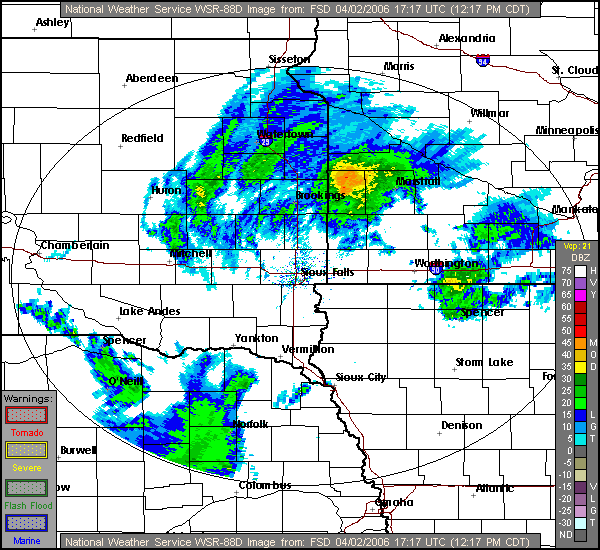
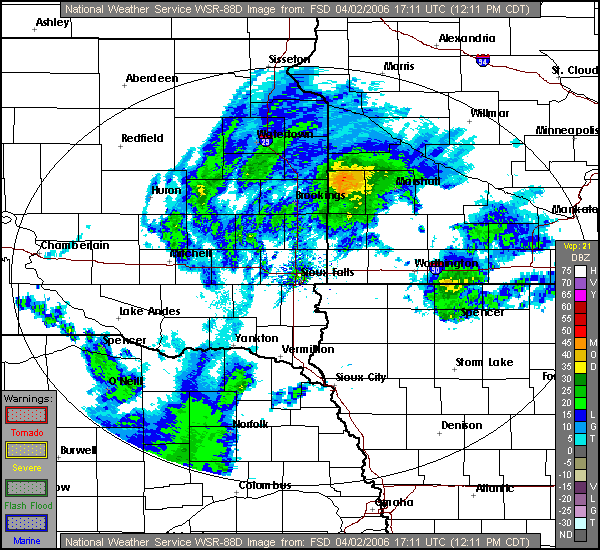
Weather Radar - Base and Composite Views during the QSO
On Sunday, Jon headed back to EN15 before going home. He arrived in EN15wb and we started out on 10 GHz. There was some
rain in the area and signals were 599 with a slight hint of associated rainscatter hash. We went at it on 24 GHz
for about 20 minutes with nothing heard. At that point Jon asked for a heading, and he noticed he was off heading quite a bit. We had
peaked up on 10 GHz rainscatter but off the side of a cell. So we re-peaked on 10 GHz for the direct path. Jon then reoriented the 24 GHz
dish and we went back and forth again for about 15 minutes. During the sequences I noticed that a stronger thunderstorm cell was
moving into the path, but it was about 3/4 the total path distance from me and only a 1/4 distance of the total path from Jon.
I got Jon on the cell phone and explained the thunderstorm location and my experiences with closer in cells via rainscatter on 24 GHz. One
needs to elevate the dishes for sure. We were pretty sure that our azimuth was correct. I decided to leave my dish on the horizon
and discussed with Jon that I wanted him to beacon while he slowly elevated his dish. While he did this, I watched the bandscope on the
SDR-1000 at the same time. So Jon slowly began to elevate and got to about 5 degrees, nothing heard. I asked him to move it up more
and there he popped out on the bandscope! I yelled into the cell phone "DON'T MOVE ANYTHING!" and we proceeded to work the QSO!
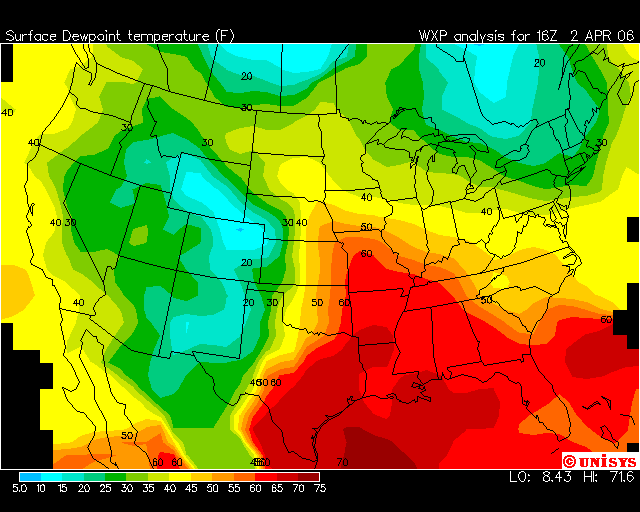
Dewpoint Chart just before QSO time
When we got done with the QSO, we went back and spent some time re-peaking the dishes on both sides. Again, our azimuth was right on,
but signals got peaked a bit more with fine tuning the dish elevations. I ended up being elevated only a few degrees, while Jon's dish was elevated
a solid 10 degrees. This all made perfect sense for the geometry, based on the cell location. The wild part was that with everything being
so wet and humid we did not think we had a chance. The RH was pretty much 100% on both ends, but the dew points were down in
the low 40s as it was pretty cold out, the low 40s as well. Winds were light to medium, 5 to 15 MPH.
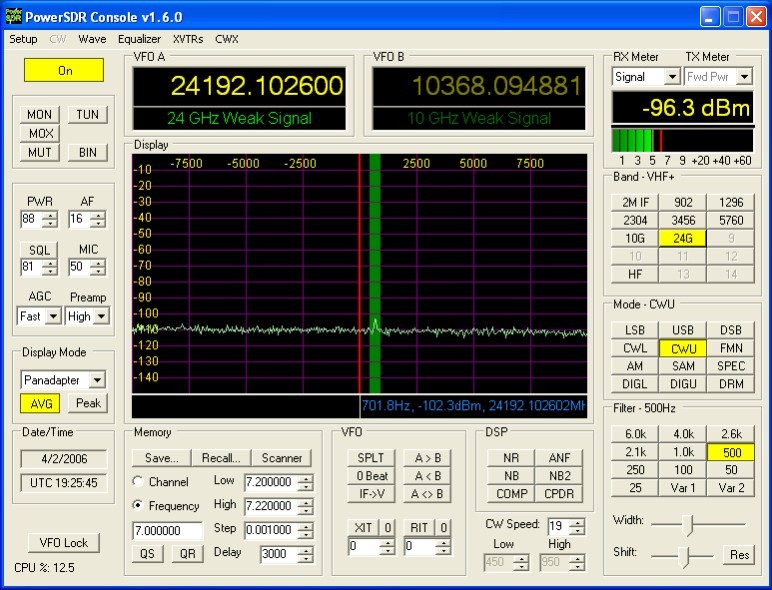
WØZQ on the SDR-1000 Bandscope during the QSO
Below are a few pictures at the KMØT location right after QSO time.
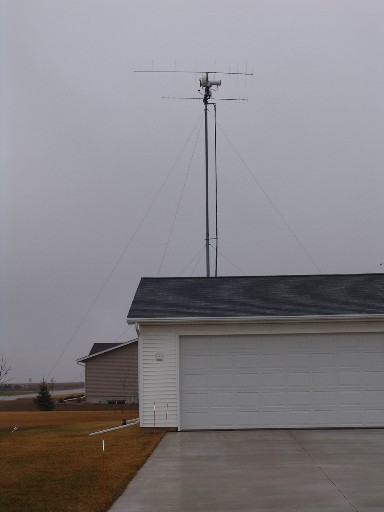
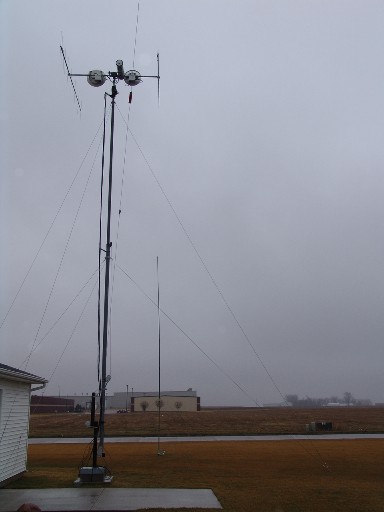
Note the slight elevation in the dishes (no the tower is not falling over - it just looks that way for some reason)
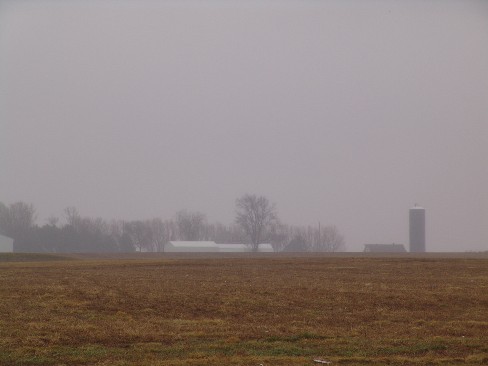
Fog and visibility at EN13VC
I went outside to take a few pictures of the conditions...it was misting and there was fog in the distance. Visibility was only
about 3/4 of a mile. Everything was soaking wet - that damp wet cold feeling. It was the same on Jon's end as well.
So much for water vapor loss! I recall Andy - KØSM indicating that if we elevate, as the signal goes higher in elevation,
it will potentially experience less water vapor loss over its path. Perhaps that and the lower dew points is
what made this all come together. Andy's "Rainscatter" program again played an important role!
Thanks to Jon - WØZQ for going to EN15 again...third times a charm!
WØZQ with the Angle Determination
Do 10 GHz signals yield to 24 GHz signals? - Note how wet it all was and the fog in the distance
Showing relative elevation of the 24 GHz dish. Hope Jon had some boots!
I completed the day when there was lots of rain between me and EN34. I turned on my 10 GHz beacon sender and left it on for
about 5 minutes and then followed it up with a long CQ. Well, there was Bob - WØAUS in EN35. That was pretty neat!
Kinda Old News!!!!
2006 is starting off good!
The "Gridinator" claims its 16th and 17th Grids! Via forward tropo scatter on 1-7-06
The contacts were made with Gene - NØDQS using one of the KMØT portable 24 GHz units.
EN13vc to EN01wx - 124.9 miles - 201 km - 419 cw signals with QSB. This is our best tropo DX to date.
EN13vc to EN04xa - 111.7 miles - 179.7 km - 419 cw signals with QSB.
Both paths were direct and set up via 10 GHz liaison - signals were very good on 10GHz.
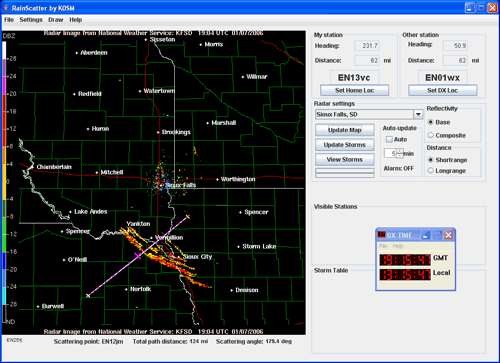
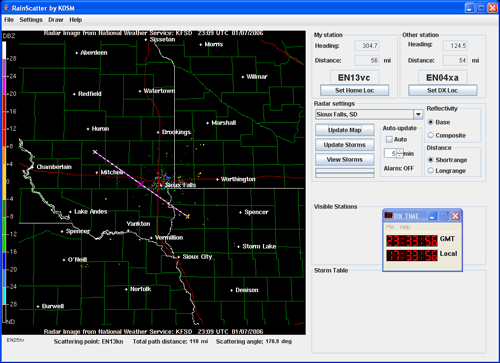
Note the slight line of in air precip near the scatter point on the EN01 contact. We noted a slight rasp on 10 GHz,
but nothing was noted on 24 GHz. When I saw that on the radar, I thought we would have an easy time of it,
but signals were weak and copy was just above the noise with QSB. Thinking back, I wonder if we both had
elevated the dishes, that we might have been able to take advantage of whatever it was. Temps on my side were
in the mid 30s, DP was the same. Gene's side had temps in the low 50s with DPs in the low 30s. We had a 20 degree
temp gradient in that short distance. I believe signals were attenuated due to the clutter in town I have to shoot
through to get to the EN01 location. The EN04 contact had just about as weak signals. Temps were quickly dropping
as Gene got there around sunset. No precip was evident on radar. Even with the slightly shorter distance, I believe
the signals again were attenuated by high metal buildings not far from my location in the path. Gene and I have tried
both these paths before from my rooftop before I mounted the "Gridinator" on the tower. Apparently the extra 20+
feet was enough to get some signal over the tops and through the obstructions in town. I'm glad these grids are done!
Old Current News!
(I'm not ready to delete this yet!)
The "Gridinator" claims its 14th and 15th Grids! Via Snow-Scatter on 12-31-05
The contacts were made with Jon - WØZQ using one of the KMØT portable 24 GHz units.
EN13vc to EN25wb - 170.4 miles - 274.2 km - 56 to 57 snow scatter signals!
EN13vc to EN35ab - 175.6 miles - 282.5 km - 52 snow scatter signals!
Both paths were direct and set up via 10 GHz liaison - signals were very good on 10GHz.

Above is a Rainscatter! screen shot of the conditions right about QSO time. The contact to EN35 looked about the same
but had reduced a bit, as the storm was breaking up it seemed - thus reduced signals at that grid.
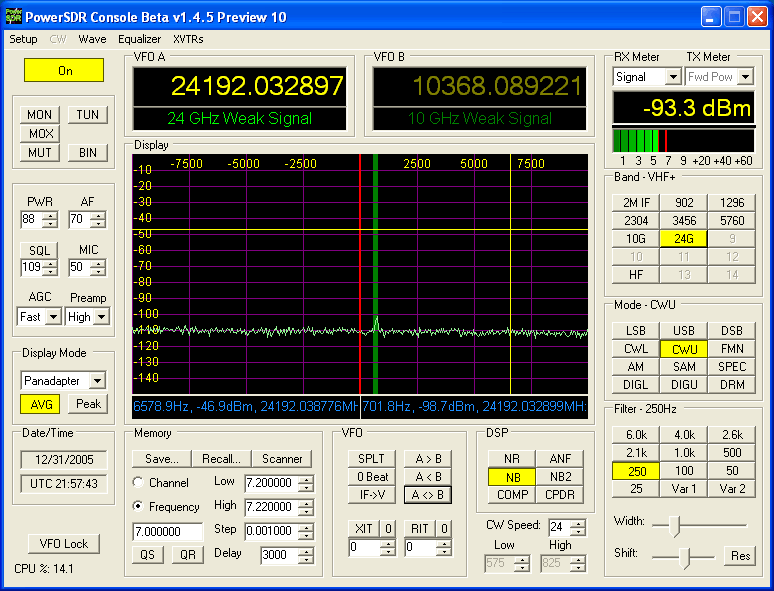
Above is a SDR-1000 screen shot showing the width of the signal and relative strength from EN25.
The signal from EN35 was a bit down, and just about as wide. Note that these signals were not really
all tore up from precipitation, as it was only slightly evident by a slight hash on the signal. I think that the
storm was moving fairly slowly and actually no precipitation was being reported by any NOAA wx stations
that I checked on where the red stuff was. It appears that it may have been evaporating before it reached
the ground. I still believe it was snow scatter however, as the radar does not lie, and on 12-11-05, we tried
the same path from EN25, but the storm had broken up by the time Jon - W0ZQ got there. Also, the dew points
and temperatures were about the same. See below for the dew point map from 12-31-05. I
recorded dew points from NOAA stations all around the red areas and a number of path points,
most were in the 27 to 30 degree range. Temps were about the same, RH was around 88 to 99%
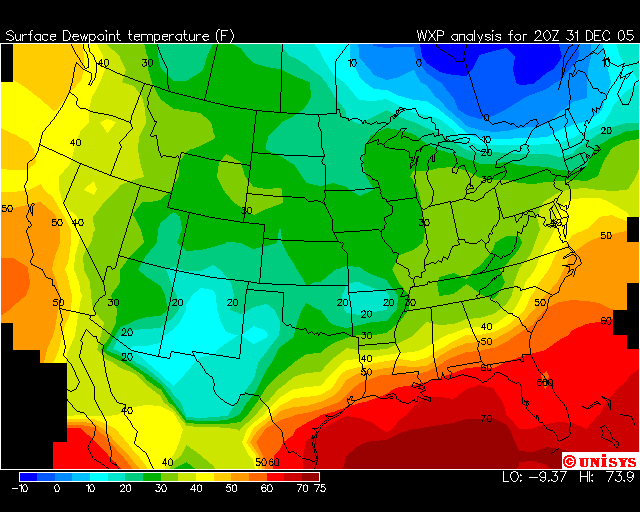
It appears that when the dew points are in the 30 degree range, this distance with some snow or freezing
precipitation at the scatter point is very repeatable. These were very easy contacts.
I think we can add 50 km at least if we can get in position. We will see what the new year brings!
Oldest Current News
(I'm not ready to delete this yet!)
The "Gridinator" claims its 13th Grid! Via Snow-Scatter on 12-11-05
The contact was made with Jon - WØZQ using one of the KMØT portable 24 GHz units.
EN13vc to EN34fs - 175 miles - 282 km - 54 to 55 snow scatter signals!
Path was direct and pretty sharp, not much leeway.
Here is the screen shot from KØSM - Andy's Program - RainScatter.
( I think we need to rename this program during winter use )
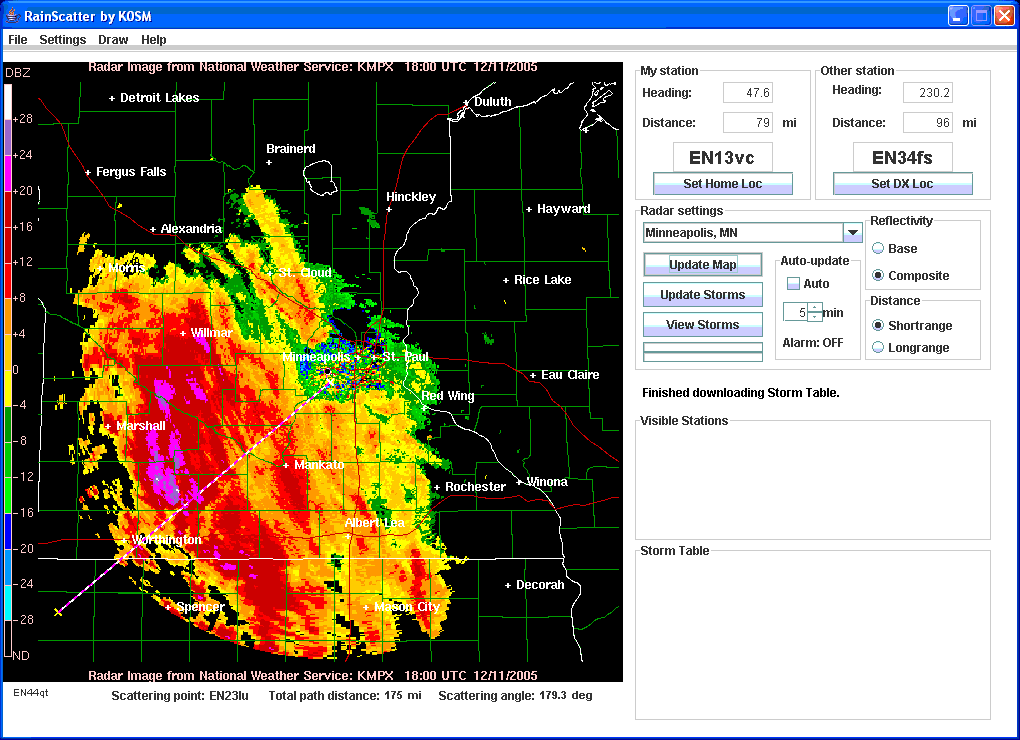
Here is a screen shot of what the signal looked like on the SDR-1000.
This is a CW signal - note the spreading of the bandwidth. There is no distinction
between 2 Meter auroral CW and what this 24 GHz snow scatter signal sounds like!
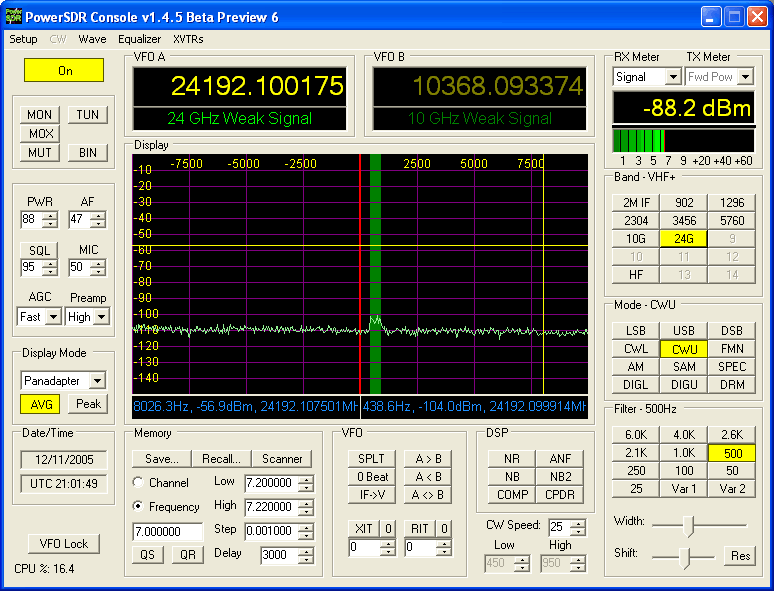
We started out on 10 GHz to peak the dishes with 5x8 aurora style signals.
When I went to 24 GHz, there he was!
We had been trying this path for months, looks like the conditions were right.
At EN13vc - 34 degrees - DP was 30 - RH was 87%
At EN34fs - 17 degrees - DP was 9 - RH was 70%